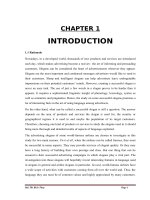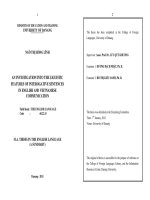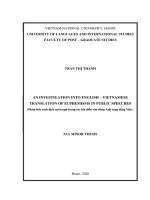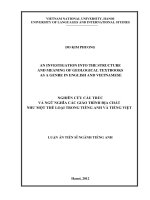An investigation into learning style preferences of efl primary school students
Bạn đang xem bản rút gọn của tài liệu. Xem và tải ngay bản đầy đủ của tài liệu tại đây (762.63 KB, 87 trang )
MINISTRY OF EDUCATION AND TRAINING
QUY NHON UNIVERSITY
_____________
DO HOANG LE VY
AN INVESTIGATION INTO
LEARNING STYLE PREFERENCES
OF EFL PRIMARY SCHOOL STUDENTS
Field: Theory and Methodology of English Language Teaching
Code: 8140111
Supervisor: Vo Duy Duc, Ph.D
BỘ GIÁO DỤC VÀ ĐÀO TẠO
TRƯỜNG ĐẠI HỌC QUY NHƠN
_____________
ĐỖ HOÀNG LÊ VY
NGHIÊN CỨU SỞ THÍCH VỀ PHONG CÁCH
HỌC TIẾNG ANH CỦA HỌC SINH TIỂU HỌC
Ngành: Lý luận và phương pháp dạy học bộ môn Tiếng Anh
Mã số: 8140111
Người hướng dẫn: TS. Võ Duy Đức
i
STATEMENT OF AUTHORSHIP
I hereby acknowledge that this study is mine. The data and findings
discussed in the thesis are true and have not been published elsewhere.
Quy Nhon, 2023
Do Hoang Le Vy
ii
ACKNOWLEDGEMENT
The completion of my master’s thesis is due not only to my own efforts,
but also to the aid of organizations and people to whom I express my deepest
appreciation. I take this chance to express my deepest thanks to them for their
support.
First and foremost, I would like to express my deepest gratitude to my
thesis supervisor, Dr. Võ Duy Đức, for his continuous support, expert guidance,
and patience throughout the study. He provided me with assistance at every
stage of the process and always expressed his faith in me. I am gratefully
indebted for his very valuable comments on this thesis.
I would also like to express my heartfelt gratitude to the headmaster at
Australian Languages Center in Quy Nhon City and to the teachers who
devoted their time to supporting me to complete this thesis.
I was also thankful to my colleagues for their support during my study
time. I am also grateful to Quy Nhon University, Post-graduate Department,
and the Foreign Languages Department for the administrative assistance.
Last but not least, special thanks from the bottom of my heart to my
parents who took care of my mental and physical health with unconditional
affection. I could not have finished this thesis without their continued support
and encouragement which gave me strength and confidence to fulfill my dream.
iii
ABSTRACT
Students use different styles or ways of receiving and managing
information during learning. Identifying learning styles among different
students can help students try to strengthen their preferred learning style and
improve other nonpreferred learning styles. This study aims to examine the
preferred sensory modality and the learning preferences of EFL primary school
students at a language center in Quy Nhon city and the correlation between
gender and learning style preferences. The participants of the study were 89
primary school students studying English at Australian Languages Center. The
data was gathered through then use of the VARK Questionnaire for Younger
People developed by 2022 and interview. The findings show that, for the
unimodal learning styles, kinesthetic is most prevalent in male and female
students. The study also reveals that multimodal learning styles were found at
all bimodal, trimodal, and quad-modal combinations. The more blend of
learning style, hence the frequency of determination of student learning style
even less. Also, no statistically significant differences were observed between
male and female students concerning their learning preferences. Despite the
limitations of a small-scale study and time shortage, the researcher does hope
that the findings would shed more light on the whole picture of learning style
preferences.
iv
TABLE OF CONTENTS
CHAPTER 1: INTRODUCTION.............................................................. 1
1.1. Rationale ................................................................................................. 1
1.2. Aims and Objectives of the Study .......................................................... 4
1.2.1. Aims .................................................................................................. 4
1.2.2. Objectives ......................................................................................... 4
1.3. Research questions .................................................................................. 4
1.4. Scope of the study ................................................................................... 4
1.5. Significance of the Study ........................................................................ 5
1.6. Organization of the Study ....................................................................... 5
CHAPTER 2: LITERATURE REVIEW.................................................. 6
2.1. Theory of Multiple Intelligences ............................................................ 6
2.2. Learning Style Preferences ................................................................... 13
2.3. Gender differences in learning style preferences.................................. 20
2.4. Related studies ...................................................................................... 24
CHAPTER 3: RESEARCH METHODOLOGY ................................... 30
3.1. Research design..................................................................................... 30
3.2. Participants............................................................................................ 32
3.3. Data collection ...................................................................................... 32
3.4. Data Analysis ........................................................................................ 34
CHAPTER 4: FINDINGS AND DISCUSSION ..................................... 36
4.1. Learning style preferences of primary school students ........................ 37
4.2. Learning style preferences by gender ................................................... 39
4.2.1. Findings from Questionnaire .......................................................... 39
4.2.2. Findings from Interviews................................................................ 44
4.3. Discussion ............................................................................................. 48
4.4. Summary ............................................................................................... 54
CHAPTER 5: CONCLUSION................................................................. 56
5.1 Summary of the key findings ................................................................. 56
v
5.2. Implications........................................................................................... 58
5.3. Limitations ............................................................................................ 59
5.4. Suggestions for further research ........................................................... 59
REFERENCES .......................................................................................... 61
vi
LIST OF TABLES
Table 1 VARK Learning Style by Gender p. 40
Table 2 Multimodal Learning Style Based on Gender p. 41
vii
LIST OF FIGURES
Figure 1 Overall Learning Style Preferences distribution p. 37
Figure 2
Figure 3 Students’ Learning Style Preferences Frequency p. 38
Figure 4
Figure 5 Percentage
Figure 6
Determination of Unimodal VARK Learning Style by p. 40
Gender
Determination of Multimodal VARK Learning Style p. 41
by Gender
Specific Learning Style Preferences distribution in p. 42
males
Specific Learning Style Preferences distribution in p. 43
females
1
CHAPTER 1: INTRODUCTION
This chapter introduces the rationale, the objectives, the scope, and the
research questions of the study. Besides, the significance and the outline of the
study are also mentioned.
1.1. Rationale
Second language is a socially dominant language needed for education,
employment, and other basic purposes. Second language also calls a foreign
language, which is might be used for cross-cultural communication situations
or studied as a curricular requirement (Troike, 2006). Nowadays, learning
foreign language earlier is important, because learning foreign language can
make children who learn it become more proficient in their native language and
will be able to communicate with a foreigner. There are great uses of English
as a foreign language in the modern world, especially in education.
Psycholinguistic study shows that childhood is considered as the golden
age for a young learner to learn the foreign language. That’s why in this modern
era, parents are looking for a school that provides an English lesson for their
children. In fact, in 21st century learning, students must have the ability to solve
problems, think critically, find and evaluate information and can productively
collaborate and communicate with other students.
Throughout their educational journeys, individual pupils employ various
learning methods and get knowledge from a variety of sources. An individual's
natural, ingrained, and preferred method of taking in, processing, and
remembering new knowledge and abilities can be referred to as their learning
style. Distinct pupils have distinct learning preferences, with a preference for a
certain sensory mode to receive and process that learned information. As a
result, it is crucial to determine each student's unique learning style in order to
support that type and enhance other less favoured learning styles.
2
One of the challenges in the world of education lies in how to make
students accustomed to critical and creative thinking in solving problems, so
that educators are required to play an active role in the learning process. As a
matter of fact, before deciding upon a definite teaching approach, educators
should realize that every learner has his/her own way of learning. Students learn
by seeing and hearing, reflecting and acting, reasoning logically and intuitively,
analyzing and visualizing. Teaching methods also vary. If the teaching style of
the instructors doesn’t match with the students’ learning styles, the students
may get bored and inattentive in class, do poorly on tests, and get discouraged
about the courses, the curriculum, and themselves. In any case, the students’
learning styles should guide teachers and help to build the independent teaching
style of the instructor. Within time, the instructor gains experience that is useful
to determine the possible working teaching method according to the needs of
the students. A lot of teaching and learning ways and theories that can help to
meet the needs of students to have interaction with somethings, friends, and
environment around them.
Howard Gardner defined learning styles as the manners in which a
person handles a variety of activities. According to Gardner’s Theory of
Multiple Intelligences (1983, p. 8), "They have been classified in a number of
different ways; they are visual, auditory, and kinesthetic, impulsive and
contemplative, right brain and left brain, etc.”. Gardner contends that the
concept of learning styles lacks precise standards for what constitutes a learning
style, from where it derives, and how to identify and evaluate it. He
characterizes the notion of learning styles as "a hypothesis of how an individual
approaches a range of materials" (Gardner, 1983, p.2).
Dunn and Griggs (1998) defined learning style as the attitude, favorites,
and conducts that learners utilize in their learning. Moreover, according to them,
the learning method might have a lot or a bit of differences. For instance, do
3
you remember the name of a person if you see it written down?
If you prefer to learn it by seeing the written name you are a visual learner.
Otherwise, if you prefer to learn it by listening you are an auditory one. In other
side, Paul (2013) stated the “learning style” that teachers and parents should
focus on is the universal learning style of the human mind and two
characteristics of it in particular. First of all, students benefit from encountering
information in multiple forms. They learn more, for example, from flashcards
that incorporate both text and images or charts, graphs, etc. than from cards that
display text alone. Second, students’ interest is kept alive by novelty and variety,
so regularly turning away from textbooks and blackboards is key. “As long as
the new activity genuinely informs the students about the academic subject at
hand, clapping a math lesson or sketching in science class, or acting during
story time can help every student to learn better” (Paul, 2013, p. 2)
Since learning styles are a property of each student and each one
contributes a unique learning style to the classroom, they are significant in the
teaching of learning processes. In order to give each student with the best
teaching methods possible, a teacher must be able to recognize the different
learning styles of their students. Learning style refers to how students receive
and process the knowledge their teacher imparts to them in the classroom.
Considering this, Candler and Joe (2009, p. 1) state "behaviors and attitudes are
some factors used to identify learning styles and options to facilitate learning".
Based on the aforementioned concepts, the author hopes to learn more about
the English language learning preferences of the students in Australian
Languages Center.
Based on the discussion above, I want to conduct a research about pupils’
learning style preferences by the title “An investigation into learning style
preferences of EFL primary school students”.
4
1.2. Aims and Objectives of the Study
1.2.1. Aims
The study aims to investigate learning style preferences of primary
school students in Quy Nhon city and to point out the correlation between
learning style preferences and gender differences.
1.2.2. Objectives
Based on the aims previously mentioned, the objectives of the study are
as follows:
- To identify all the learning style preferences of EFL primary school
students based on Theory of Multiple Intelligence.
- To find out correlation between gender and learning style preferences.
1.3. Research questions
To achieve the above aims and objectives, the reseacher collected data and
analyzed it to answer the following questions:
1. What are EFL primary school students’ learning style preferences?
2. What is the correlation between learning style preferences and gender
differences?
1.4. Scope of the study
Although there are many theories about learning style preferences, this
study focuses on Theory of Multiple Intelligences for young learners in primary
school. Moreover, to make the research manageable, the subject to conduct this
study merely concentrates on young learners in primary school. There are 89
primary school EFL learners in a language center in Quy Nhon city. There are
male and female students aged from 8 to 11. The pupils involved in this
research are from varied educational background as well as taught by different
English teachers and no pupils are excluded from the study.
5
1.5. Significance of the Study
The findings of this study will partly contribute to the benefits of learning
English in our society. Primary school students who are the launch of lifelong
journey diving into this foreign language should have appropriate paths for
learning the right way from the start. This research is expected to be beneficial
for teachers to improve their creativity and competence with learners’ learning
styles, especially for those who teach young learners.
1.6. Organization of the Study
This thesis is organized into five chapters. The first chapter gives a brief
introduction about the rationale of the research, research questions, the aims
and objectives, the scope, the significance as well as structure of the study. In
the next chapter, a fundamental overview of theoretical concepts relating to the
research provided. The third chapter presents methods used to collect data and
information of participants. Questionnaires, and interviews are described in
more detail. In the fourth chapter, collected data are calculated and analyzed to
draw some conclusions about primary school students’ learning styles
preferences and correlation between them and gender differences. Finally, the
study summarizes the research findings, offers implications as well as
limitations of the study and makes suggestions for classroom practice and
further research.
6
CHAPTER 2: LITERATURE REVIEW
This chapter discusses general issues about Theory of Multiple
Intelligences, learning style preferences and the correlation between learning
style preferences and gender.
2.1. Theory of Multiple Intelligences
Today's world is characterized by quick and widespread advancements
in science, technology, and communication as well as the emergence of fresh
perspectives on social, political, economic, and cultural concerns (Otaghsara,
2014). These innovations have a profound impact on educational institutions
and teaching strategies.
Intelligence is of paramount importance in a person’s life. Consequently,
both academics and the general public are very curious about and interested in
the subject of intelligence (Mackintosh, 1998). It has been shown that there are
many different types of intelligence, including general, interpersonal, fluid, and
crystalized intelligence.
For a long time, educators have used traditional teaching strategies in the
classroom that have a tendency to categorize students as members of a single,
homogeneous group. Teachers use the executive approach to impart knowledge
to all of the students using a common set of teaching strategies (Sulaiman et al.,
2011). Teachers encounter difficulties while attempting to meet the variety of
student learning preferences and needs using the standard teaching
methodology. Besides, learning preferences and characteristics are linked to
how an individual perceives and engages with their environment.
Within the context of the student-centered classroom, research interest
in learners’ individual differences has begun to expand (Ellis, 2012).
Additionally, research has begun to investigate individual variations that can
improve classroom learning. According to language learning researchers,
7
multiple intelligences and learning styles have the potential to have a positive
impact on classroom instruction (Reid, 1998). Students are more likely to be
responsive to our instructional tactics and forms of presentation if we tailor
them to their preferred learning styles and take into account their use of multiple
intelligences. The existence of different learning styles and different types of
intelligences has thus been confirmed by the theories of multiple intelligences
(Christison, 2005; Gardner, 2006) and learning styles (Kolb, 2014; Oxford,
2003). Reid (1998) stated that "internally-based characteristics, often not
perceived or consciously used by learners, for the intake and comprehension of
new information" are what learning styles are. A person's intelligence can be
measured by their problem-solving and creative capacities, both of which are
considered to be highly desirable in multiple cultural contexts according to
Gardner's (2006). He cast doubt on the notion that intellect could be measured
by "IQ" score or a single number. Following this, researchers have found a
number of generic teaching practices that can take into account students'
learning preferences and multiple intelligences, such as instructional models
that depart from the conventional lecture format, such as visual presentations,
site visits, and Internet usage.
According to the hypothesis of multiple intelligences, which was
developed by psychologist Howard Gardner in the late 1970s and early 1980s,
people have at least eight reasonably independent intelligences. People use
these intelligences, both individually and collectively, to develop goods and
find solutions to issues that are pertinent to the societies in which they live
(Gardner, 1983, 1993, 1999, 2006). The eight types of intelligence that Gardner
(1999) described are linguistic intelligence, logical-mathematical intelligence,
spatial intelligence, musical intelligence, bodily-kinesthetic intelligence,
naturalistic intelligence, interpersonal intelligence, and intrapersonal
intelligence. It is helpful to think of that language-logic combination as
8
"academic" or "scholarly intelligence" because, in Gardner's perspective, only
two intelligences - linguistic and logical mathematical - have been recognized
and tested for current secular schools. The theory of multiple intelligences, or
multiple intelligences theory, departs from traditional conceptions of
intelligence by viewing intelligence as multiple rather than unitary in nature.
These conceptions were first put forth in the early 20th century, are still
measured by IQ tests, and were extensively researched by Piaget (1950, 1952)
and other cognitively oriented psychologists.
Neither the multiple intelligences theory nor any other theory that views
intelligence as pluralistic is the only one that challenges Spearman's (1904,
1927) notion of general intelligence. In addition to others, Thorndike (1920;
Thorndike, Bregman, Cobb and Woodyard, 1927) saw intelligence as the
combination of three different types of intelligence: abstract intelligence,
mechanical intelligence, and social intelligence. According to Thurstone (1938)
and Thurstone and Thurstone (1941), intelligence can be better understood as
being made up of seven fundamental skills. In the conceptualization of
intelligence, Guilford (1967) and Guilford and Hoepfner (1971) divided it into
four content categories, five operational categories, and six product categories.
They finally identified 150 separate intellectual faculties. Analytical, creative,
and practical intelligences were recognized by Sternberg's triarchic theory of
intellect, which was presented in 1985 and 1990. Lastly, Ceci (1990, 1996) has
described a variety of cognitive potentials that allow for the acquisition of
knowledge and the consideration of links between concepts and ideas.
The most well-known of these pluralistic views is perhaps Gardner's
hypothesis of many intelligences. This notoriety is a result of its enthusiastic
acceptance by the educational community as well as the sources of information
on which Gardner drew (Armstrong, 1994; Kornhaber, 1999; Shearer, 2004).
The mission, curriculum, and pedagogy of many thousands of schools all over
9
the world now include multiple intelligences concepts, and hundreds of books
(in many different languages) have been written on the topic of the applicability
of MI theory to teachers and educational institutions (Chen, Moran, and
Gardner, 2009). A 10-acre "science experience park" with more than 50 unique
exhibits opened in Sonderberg, Denmark, in 2005, allowing visitors to discover
their unique intelligence profile (Danfoss Universe, 2007). The main points of
this expansive theory are outlined in the sections that follow, along with a few
of the changes that have been made to it during the past 25 years.
Multiple intelligences have biological and cultural roots, according to
Gardner. Accepting Gardner's theory of multiple intelligences has a number of
effects on how teachers should instruct students in the classroom. According to
the notion, each of the seven intelligences is necessary for productive social
interaction. Children cannot be evaluated the same way because they all learn
differently. Consequently, it is crucial that a teacher develops "intelligence
profiles" for each pupil. The teacher will be able to accurately evaluate the
student's development if they are aware of how each student learns (Lazear,
1992).
Multiple intelligences are especially useful in the context of education
and student accomplishment because they assist parents and instructors
comprehend education holistically. According to Gardner (1994), multiple
intelligences influence parents and educators to question their own beliefs and
presumptions about student accomplishment and take into account alternative
instructional strategies. This idea offers a potent lens through which to examine
different intelligences in relation to secondary student performance.
Gardner and Hatch (1989) defines intelligence as a bio-psychological
ability of processing information that can be activated to handle a problem
appropriately and create a product that is valued in a cultural setting. This
definition extends the meaning of the word intelligence beyond its typical
10
application in psychology. He created the hypothesis of multiple intelligences
and claimed that each person possesses not just one general intelligence but
also several intelligences. The notion of many intelligences advocates the idea
that everyone is capable of learning using a variety of distinct intelligences. The
six intelligences he originally suggested were later supplemented by two more
(Gardner, 1999).
The first type is linguistic or verbal intelligence, which incorporates
language expertise. People that are verbally intelligent frequently think in
words and have exceptionally strong aural abilities. Frequently, they are either
reading or writing.
The second type of intelligence is logical-mathematical intelligence,
which includes the capacity for pattern recognition, deductive reasoning, and
logical thought. As a result of their ability to comply to the standards of a model
student and follow the logical sequencing of the teaching, these kids typically
perform well in the regular classroom.
Spatial intelligence is the third one. This can modify and produce mental
representations using this intelligence to find solutions to problems. To conduct
changes and adjustments on one's initial perception, spatial thinkers accurately
perceive the visual world (Gardner, 1999, p. 173). People with this level of
intellect typically learn best through visual presentations like movies, images,
videos, and model-based demonstrations.
Bodily-kinesthetic intelligence is the fourth. It involves the capacity to
perceive reality through the body. These people have a very expressive,
sophisticated manner of using their body for a certain purpose.
The fifth trait is musical intelligence. It utilizes sound as much as is
physically possible. Pitch, rhythm, and timbre are concepts well-understood by
those with musical intelligence.
11
Interpersonal intelligence comes in sixth. It includes the capacity to
recognize, interpret, and distinguish between people's emotions, motives, and
intelligence.
Intrapersonal intelligence is the seventh. Intrapersonal focuses more on
the person as a whole. It is the capacity to comprehend one's own functioning
and to know oneself.
Natural intelligence comes last. Understanding the symbols found in
nature and respecting the delicate balance that allows humans to survive are
both necessary. They truly appreciate the various facets of nature and how they
interact.
These descriptions of the eight intelligences that make up the multiple
intelligence theory were based on the fields or disciplines where one would
generally find people who exhibit strong evidence of each intelligence. This is
due to the fact that there are now no psychometric or neuroimaging methods
available to evaluate a person's potential for a specific intelligence directly. For
instance, no test has been developed to directly determine if a person has a
profile of intelligences high in spatial intelligence; however, it is reasonable to
assume that someone who performs exceptionally well in the fields of
architecture, sculpture, or geometry has high spatial intelligence. Like ballet or
orthopedic surgery, excellence in these fields indicates a high level of bodily-
kinesthetic intelligence. Future research may result in the development of more
accurate methods for assessing intelligence, such as those based on knowledge
of neuronal architecture or even genetic markers.
After reflecting on the theory for 25 years, Gardner emphasizes two main
points: (1) Every person possesses the whole range of intelligences; in a
cognitive sense, intelligences are what make up the human species; and (2) No
two individuals, not even identical twins, have exactly the same profile of
intellectual strengths and shortcomings. These represent the theory's main









